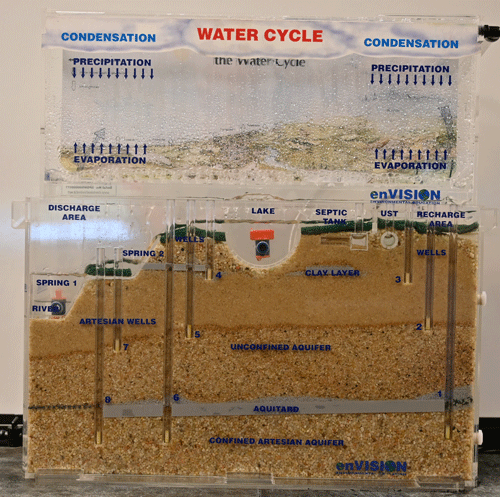Virtual Lab: Groundwater Contamination Simulation Lab 2
Even though groundwater only makes up an estimated 0.61% of the water on Earth, it accounts for 98% of the available freshwater (Fetter, 1999). In many parts of the world (including southwestern North America) water is the primary limiting resource for society and the surrounding ecosystems. Despite the central role of groundwater’s importance to society, few citizens understand even the basics of groundwater flow. You need to understand the fundamentals of groundwater flow and contamination. It may save you thousands of dollars when purchasing a home, it may save your community millions of dollars in clean-up costs, and it might preserve the rich biotic diversity in riparian areas.
In this lab, we will explore the basics of groundwater movement, the effects of pumping wells, and groundwater contamination using recorded videos of a groundwater simulator.
Something to Think About:
We rely on groundwater - it's the water we drink, the water that grows our food, the water that helps recharge our lakes and rivers. While some groundwater contaminants are naturally occurring, unfortunately, the majority of groundwater contamination is the result of human activity.
- Groundwater Contamination
- Overuse & Depletion
- Nitrates
- Pharmaceuticals & Personal Care Products
- Improperly managed on-site wastewater treatment systems
Background for Groundwater Contamination Simulation Lab
This is the groundwater model we will use to collect data for this lab.
Vocabulary you need to know:
Part 1 - Observation:
Make a copy of the student handout. Once you have a copy of that, use the links to the contamination runs below to complete parts 1 and 2 of the lab.
Part 2: Interconnected Systems
Pollution of groundwater can cause major societal problems (see the recent movies Erin Brockovich and A Civil Action). The purpose of this part of the lab is to investigate how landfills, septic systems, manure pits, underground gasoline storage tanks, or other "point sources" of pollution can contribute pollutants to the groundwater, and to observe the direction in which those pollutants move.
Use the contamination run videos in Part 1 to complete the table in the student handout.
Part 3: Identifying the Source of the Pollutant
For each of the data sets, use what you have observed about the flow of groundwater and contaminants in the previous sections and the following graph to determine the most likely location of the contaminant.
Below is the process of collecting water samples at various wells to measure the contamination.
How to create the groundwater standard curve.
